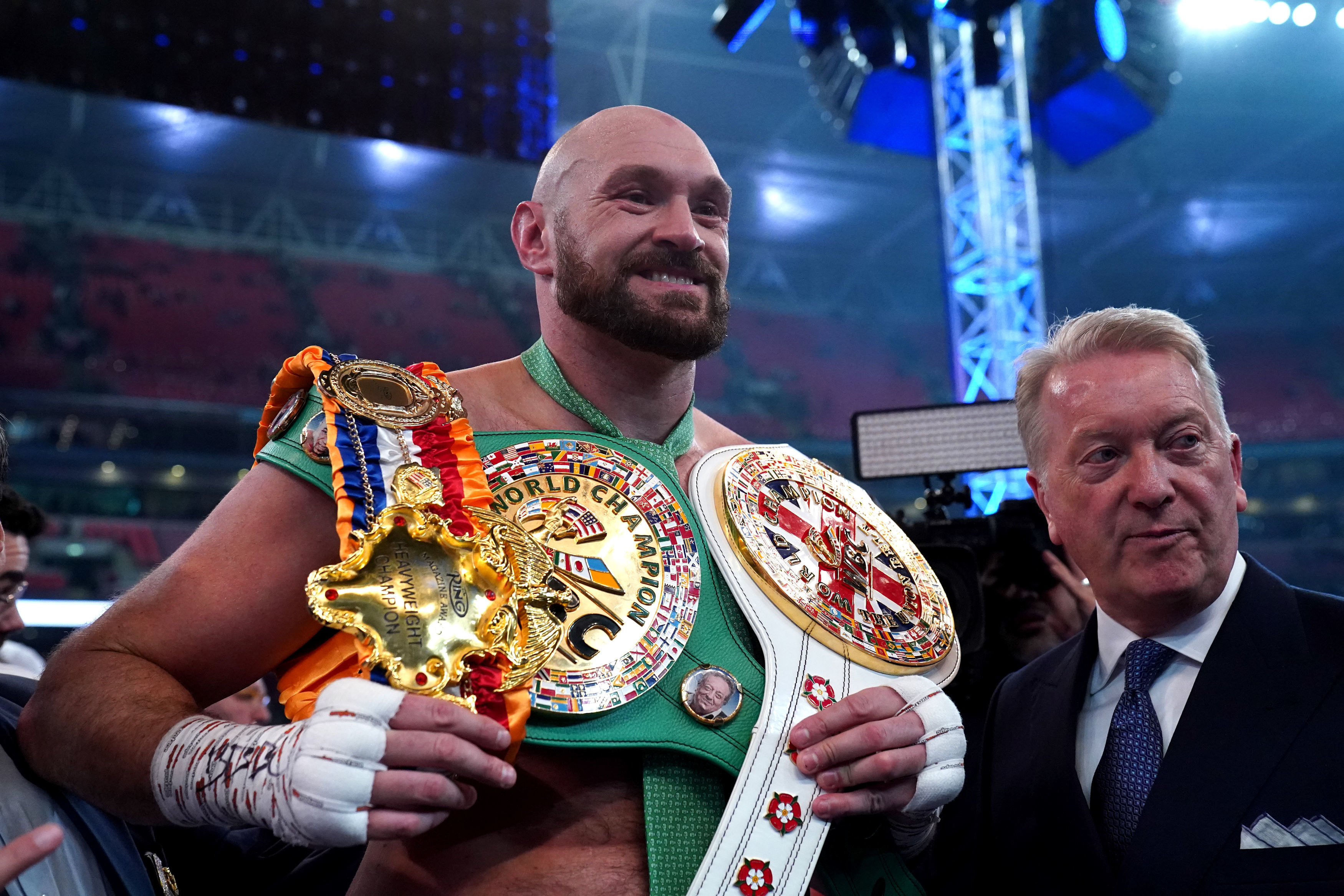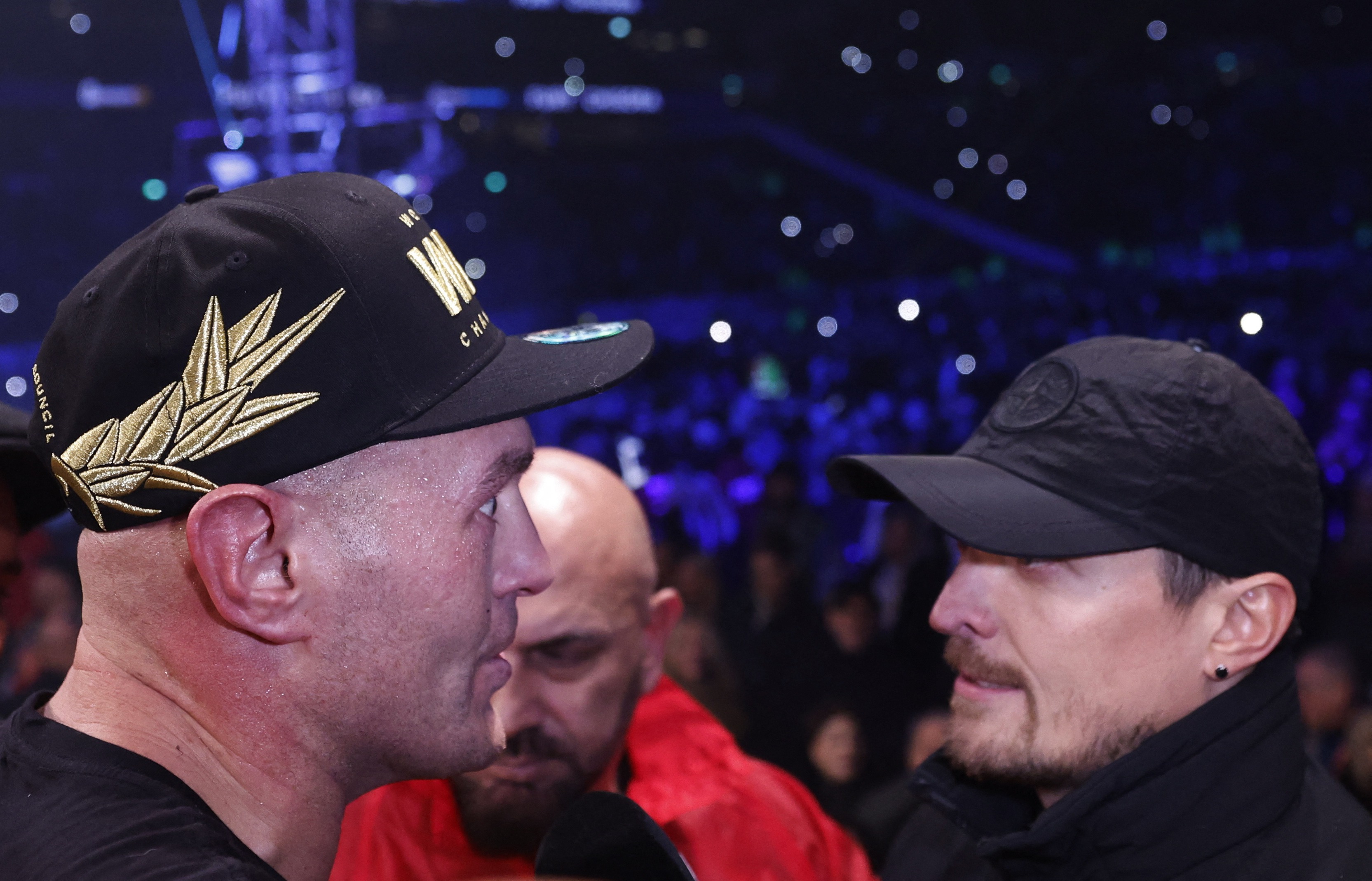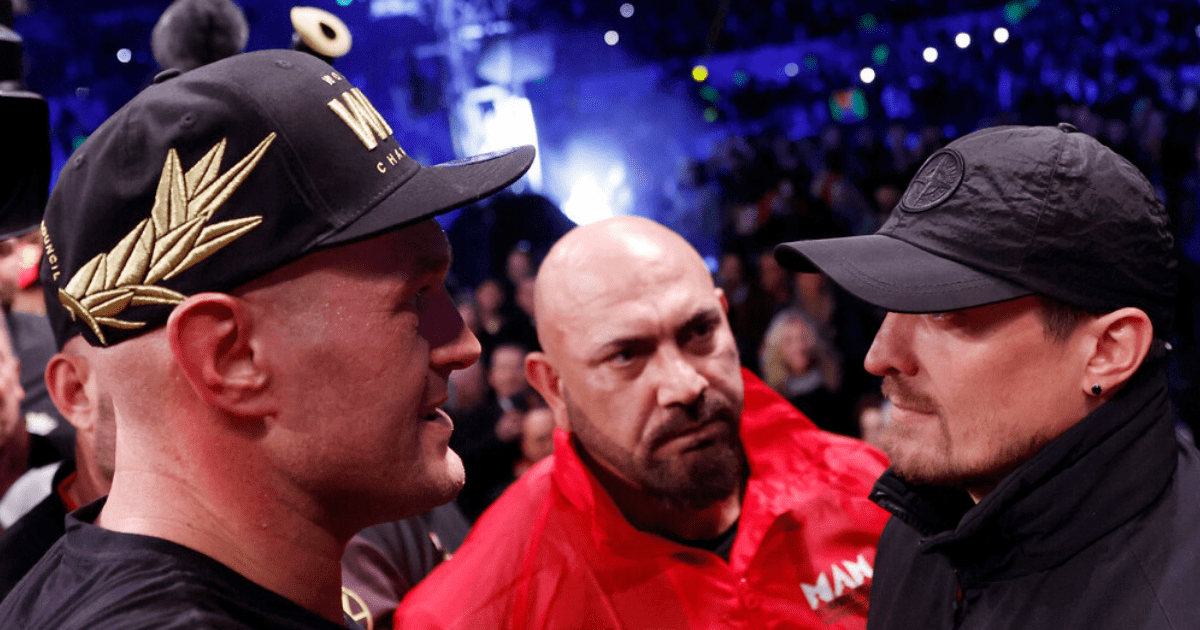TYSON FURY’s historic showdown with Oleksandr Usyk is set to take place later than initially expected.
Talks over a blockbuster undisputed clash between the undefeated heavyweights resumed after Fury’s lopsided beatdown of Derek Chisora last December.
Tyson Fury and Oleksandr Usyk are on course for a blockbuster undisputed bout
The mega-fight was initially targeted for March 4

But promoter Frank Warren has revealed the bout will likely happen in early April
March 4 was the initial working date, but Fury co-promoter Frank Warren has revealed a delay in finalising the deal has paved the way for an “early April” dust-up instead.
During an appearance on talkSPORT, he said: “We’re expecting a couple of offers this week, but none of them have come through and then Tyson has to make his decision.
“I hope it’s going to happen at the end of March, early April, that’s where we’re looking at the moment.
“So, fingers crossed we get it over the line for that date, but it will definitely, definitely happen.”
Negotiations are understood to be at an advanced stage, with a site deal one of the few matters to be resolved.
Warren said: “We’re very far down the road, but there are a couple of things we’ve got to work on.
“We’re trying to get to a point where we can announce it fairly soon and we all think it’s going to happen.”
Despite the delay, Warren insists Usyk and his team have been easy to work with.
CASINO SPECIAL – BEST NEW CUSTOMER SIGN UP DEALS
He said: “They have no promotional ties, they are free agents, they have no TV contracts, so that side of it is very simple.
The first undisputed heavyweight title fight in nearly 24 years is expected to land in the Middle East, although Warren has refused to rule out the prospect of it taking place at Wembley.
He said: “Tyson’s the attraction.
“In his last two fights, he’s had 160,000 people watching.
“But we’re working it out and they’re sensible people and we’re sensible people.”

Tyson Fury and Oleksandr Usyk have been going back and forth on social media
WBC king Fury has been on the receiving end of multiple call outs from slick southpaw Usyk of late, which he responded to on Tuesday.
In a video on his social media channels, he said: “Tyson Fury here.
“WBC heavyweight number one – get up world champion!
“Usyk, calling out the Gypsy King with your pathetic little callouts, dosser.
“Rabbit. I’m coming for you, rabbit. You’re getting it, rabbit.”
Frequently Asked Questions
How long does it take for a professional boxer to become one?
It takes years of hard work and dedication to become a professional boxer. If you want to become a professional boxer, you’ll need to dedicate at least 10 hours per week to training.
How to throw an emu jab
Here’s a step-by, easy guide on how to throw a jab.
- Take your step forward with both of your feet.
- Arrest your arm high above your shoulder.
- Your target is at your feet.
- Swing your arm back upwards after hitting your target.
- Repeat steps 1 to 4.
Can you learn to box?
You can learn to box. Find a local boxing gym and sign up for a class. Many gyms offer classes for free, but you can also search Google for local boxing clubs.
Also, you will need equipment such as gloves, mouthpiece, headgear, sparring partners, and headgear. Once you have everything you need, you can practice your kicks and punches.
What is the difference of a left-hook and a right-cross?
A left-hand hook is thrown on the side of a body while a lateral cross is thrown on the front.
A left hand hook is one that is thrown with the opponent’s right side facing. The elbow is bent 90° and the wrist is turned 45° toward the opponent.
A right cross can be thrown with the palm facing towards the opponent’s face, and the elbow straight. The opponent’s wrist should be turned 45 degrees.
How do you practice boxing punches.
A punching bag is used to practice boxing punches. Once you feel comfortable with the technique, you can punch the bag. You can then move on to another area of your body. Once you feel comfortable with one area, you’ll move on to the next.
What are the main types of boxing glove?
There are three types: mitts (fingerless mitts), full-fingerered gloves, and mitts (fingerless mitts). Mitten gloves have padding at the knuckles. Fingerless mitts don’t have any padding around your knuckles but still cover your fingers. Full-fingered gloves have padding throughout the entire hand.
Mittens can be used for hitting the fist with your fist. Fingerless mitt glove are for striking the index finger with the knuckle. Full-fingered boxing gloves are used for punching with the whole fist.
Statistics
- You want to be running at roughly 75-80% of your top speed..5 mile slow, easy recovery jog at the end.[6]X Research source 2Mix in long runs, shadow boxing, and short sprints on non-interval days. (wikihow.com)
- This article received 39 testimonials and 89% of readers who voted found it helpful, earning it our reader-approved status. (wikihow.com)
External Links
expertboxing.com
amazon.com
- Amazon.com: Ringside Diablo Wrestling Boxing Shoe – Clothing, Shoes & Jewellery
- Amazon.com – Sanabul Boxing Wraps Elastic 180in Red — Sports & Outdoors
How To
These are the basic skills of boxing
How to box effectively
Boxing is one of the most popular sports in the world. It involves two people who attempt to knock each other out of their heads. Each country has its own rules. There are three main types of boxing: Amateur boxing, Professional boxing, and Olympic boxing.
Amateur boxing usually takes place at school, college and university. This form of boxing involves sparring with no protection and using padded gloves. Amateur boxing matches usually consist of three rounds lasting five minutes each. There are many different styles of amateur boxing including Kickboxing, Muay Thai, Taekwondo, Karate, Judo, Wrestling and others.
Boxing is typically practiced in clubs, stadiums or gyms. They wear protective equipment such as mouthpiece, nose guard, shin guards, elbow pads, knee pads, waist belt and groin protector. Professional boxing competitions consist of six rounds lasting four minutes each. There are several different styles of professional boxing including Boxing, MMA (Mixed Martial Arts), Kickboxing, Muay Thai, Taekwondo and others.
Olympic boxing is done at the Olympics. International standards dictate that boxers must wear protective gear. The eight rounds last three minutes each and are held over eight rounds. There are only two styles of Olympic boxing; Light Flyweight and Heavyweight.
The basics of boxing are:
- Punching techniques
- Techniques for protecting yourself
- Footwork
- Stance
- Movement of the body
- Defense
- Combination
- Rotation
- Spare parts
Punching Techniques
There are seven types. Each punch comes with its own technique. Some punches are more powerful than others. A strong uppercut for example requires a lot of force. A straight punch on the other side requires less power, but is more effective than other punches.
There are many combinations of punches. These are combinations of punches which work together to achieve a goal. An entire combination could have several parts. For example, a combination of a left and right hook will result in damage to the opponent’s jaw.
Guard Techniques
A boxer protects himself by using his body. He does this using his legs and arms, elbows as well as hands, knees and feet.
Legs
A boxer must use his legs to defend against kicks. If he gets kicked, he raises one leg and turns away from his attacker. To avoid being kicked in the side, he bends down if the attacker attacks from the front. However, if the attack comes from behind, he stands up straight and blocks the kick with his foot.
Elbows
Elbow strikes are very powerful because they inflict great pain. You can either deliver an elbow strike directly, or indirectly. Directly means that you hit your opponent with your forearm while indirectly means that you hit him with another part of your arm.
Hands
Boxers use the power of their hands to block any incoming blows. To do this, they raise their fists higher than their heads and move their arms in the direction that the attack is coming. The attacker’s fist is then in their face.
Knees
Boxers who are subject to a punch to their stomachs, abdomens, or chests should bend at the knees to absorb the impact. Knee strikes are often used for defense purposes.
Feet
When attacked, a boxer should step back and deliver counter-attacks. This allows him to put distance between himself, his opponent, and the ring. A boxer must also maintain his balance when responding to an opponent’s counter-attack.
Stances
To box effectively, a boxer must establish a stance. How he defends his self will depend on how he stances. It determines his position and the direction he will face. Boxers have many stances to choose from. These are some of our most favorite:
- Low stance
- High stance
- Southpaw stance
- Western stance
The Body Movement
To win a fight, a fighter must move around the opponent. This involves changing position, speed and rhythm.
Rotation
Rotating his arm to increase the puncher’s reach is a key part of boxing. Depending on the type and size of punch, the speed at which the rotation takes place varies.
Combinations
The timing of each punch determines the effectiveness of a combination. A combination that works well starts with strong punches and ends with weak ones is a winning combination.
Spare parts
Sparring is a form of boxing that aims to improve your skills. During sparring sessions, a boxer trains his mind as well as his body. Sparring is a way to learn how to fight without getting hurt.
You need to have patience and dedication in order to learn how boxing works. To become a better fighter, you have to train hard and continue to work.

